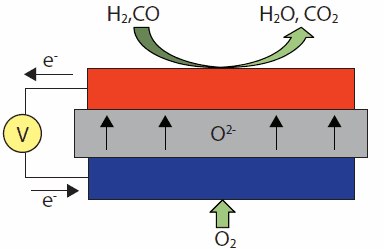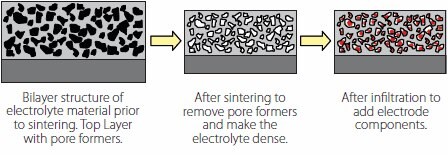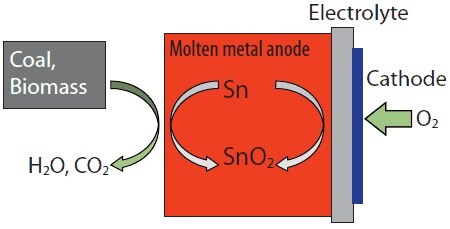Advances in Materials for Solid Oxide Fuel Cells
Introduction
As with all types of fuel cells, a solid oxide fuel cell (SOFC) is capable of efficiently transforming chemical energy into electrical energy. However, unlike fuel cells based on proton-conducting electrolytes, SOFCs are not limited to using H2 as the fuel and can in principle operate on any combustible fuel, including carbon monoxide,1 hydrocarbons,2 and even coal.3 SOFCs are based on ceramic membranes that are oxygen-ion conductors and operate according to the principles shown in Figure 1. O2 from the air is reduced to O2- anions at the cathode, and the anions are then transported through the electrolyte membrane to the anode where the fuel is oxidized.

Figure 1. Schematic of SOFC operating on H2 or CO.
None of the known oxides that are used as electrolytes show significant ionic conductivity below 773 K; therefore SOFCs must operate at relatively high temperatures, from 773 K to 1,273 K. Unfortunately, high temperatures can result in materials challenges and much of the research in SOFC has been aimed at allowing operation at the lower end of the temperature range. High temperatures, however, provide a number of important advantages. They allow the activation of molecules like O2 at the cathode and CH4 at the anode with small electrode losses (i.e., low overpotentials). Heat management is also much easier at high temperatures. In any fuel cell, the chemical energy that is not converted to electrical energy is given up as heat. This heat can be used by endothermic reforming reactions in an SOFC; even if it is to simply be discarded, heat transfer to ambient is much easier in an SOFC. Traditionally, the view has been that SOFC would be used only in large-scale power generation, but this is no longer true. Although high temperatures represent challenges for small-scale applications, portable SOFC for applications such as battery replacements and microchip power sources are being developed industrywide.
In an ideal fuel cell, the potential of the produced electrons would be increased by an amount determined from the Nernst Equation (Equation 1), a thermodynamic expression that relates the change in the voltage of the electrons to the change in the Gibbs Free Energy of the reaction.
VNernst = V° + ( RT/nF ) ln [ (PH2, anode • PO2, cathode(1/2)) / PH2O, anode ] --------(1)
Indeed, in the absence of current flow, SOFCs closely approach equilibrium and the open-circuit voltage (OCV) can be used to measure the difference in chemical potentials across the electrolyte. This is the basis for oxygen sensors used in today′s automobiles.4 However, current must be allowed to flow in order to produce energy, and losses in the electrodes and the electrolyte will cause the cell potential to decrease. For example, since the electrolyte has a resistance that can be calculated from its thickness and resistivity, the potential loss in the electrolyte is i·RE, where i is the current density in A/cm2 and RE is the resistance in Ω·cm2. The relationship between current density and overpotential losses in the cathode, ηcathode, and anode, ηanode, may be complex. Finally, the operating potential of the cell, V, will be given by Equation 2:
V = VNernst – (i • RE + ηcathode + ηanode) ------- (2)
Unlike low-temperature fuel cells such as Proton Exchange Membrane (PEM) fuel cells, where the cell potential usually decreases exponentially with current density near open circuit, the relationship between cell potential and current density is often linear in SOFCs. When the relationship is linear, the losses in the anode and cathode can be described by their impedances, Ranode and Rcathode (effectively the resistances of those components). A typical goal for fuel cell developers is to have the total cell impedance be less than 0.3 Ω·cm2, the impedance required to achieve a power density of 1 W/cm2. Since the cathode, electrolyte, and anode form a circuit in series, the losses from each component are additive, so that each component should have an impedance less than ~0.1 Ω·cm2.5
Materials in the Present State-of-the-Art SOFCs
The composition of SOFCs presently under development has not changed dramatically in the last 30 years. The most commonly used electrolyte is still yttria-stabilized zirconia (YSZ, Product No. 544779 ). Although there are oxides that have higher ionic conductivities, YSZ is relatively inexpensive and has negligible electronic conductivity under even the most reducing conditions. At 973 K, the losses associated with a 10 μm YSZ electrolyte are only 0.05 Ω·cm2. Anodes are typically porous composites of Ni and YSZ. The Ni provides electronic conductivity and catalytic activity, while the YSZ provides channels for ionic conduction within the electrode, helps maintain porosity, and helps match the coefficients of thermal expansion between the electrode and electrolyte. Because cathodes must maintain good electronic conductivity at high temperatures in air, the main component is almost always a conductive oxide, Sr-doped LaMnO3 (LSM, Product No. 704296 ). As with the anode, LSM is often mixed with YSZ to form a cathode composite (Product No. 704245 ).
Although this set of materials has not changed much since 1975,6 there have been a number of advances that have greatly lowered the operating temperature, from ~1,273 K to below 1,073 K, and have brought commercialization closer. The first of these was the development of anode-supported cells.7 While the exact fabrication details vary, these cells are prepared from a bilayer green body with a relatively thick film (~500 μm) made from a physical mixture of NiO (Product No. 481793 ) and YSZ powders and a thinner film (~10 μm) of YSZ powder. Since NiO and YSZ do not form solid solutions, this bilayer can be sintered to high enough temperatures to form a dense electrolyte from the YSZ layer. After applying the cathode to the dense YSZ (i.e., by screen printing a mixture of LSM and YSZ powders), the NiO-YSZ composite (Product No. 704202 ) is reduced to form the porous Ni-YSZ anode. In addition to the fact that this procedure results in a thin electrolyte, the co-firing of the anode and electrolyte forms an anode-electrolyte interface that is nearly ideal for promoting the electrochemical reactions. Cathode performance usually limits performance in these cells.
The second major advance has been in the use of cathodes made from Mixed Ionic and Electron Conducting (MIEC) perovskites, such as Sr-doped LaCo0.2Fe0.8O3 (LSCF, Product No. 704288).8 While LSM has high electronic conductivity, its oxygen-ion conductivity is negligible—only 10-6 times that of YSZ. By comparison, LSCF has ionic conductivity that is only about 50 times lower than that of YSZ, while maintaining high electronic conductivity. The increased ionic conductivity widens the three-phase boundary, the electrochemically active zone where gas-phase O2 can react with electrons to form oxygen ions. The difficulty with LSCF is that it readily undergoes solidstate reactions with YSZ. To avoid this problem, a micron-size thin layer of doped-ceria (Product No. 572357 ) is introduced as an interlayer between the LSCF and the YSZ to prevent solid-state reactions.8
Materials for the Future
Although the electrodes in the present materials set work reasonably well, there are a number of issues that could be improved using new formulations and fabrication methods. First, replacement of the Ni-YSZ composite (Product No. 704229 ) at the anode would open up the possibility of using hydrocarbon fuels without the need for reforming. As discussed at the beginning of the article, it is theoretically possible to fuel an SOFC with almost any combustible fuel. Unfortunately, Ni catalyzes the formation of carbon fibers from carbon hydrides, which can deactivate the cell and cause stresses that lead to its fracture or loss of Ni via corrosion known as “metal dusting”. By replacing Ni with Cu or a conducting ceramic, the SOFC can operate directly on methane and even liquid fuels.1, 2
The problem with Ni-anode replacements has been that their anode impedances have been too high, requiring significantly higher temperatures to achieve similar power densities to those achieved with SOFC based on Ni-YSZ anodes. The impaired performance is partially due to the fact that one cannot use the co-sintering process that is used with anode-supported cells to achieve the nearly ideal electrodeelectrolyte structure. Essentially all materials that could be used to replace Ni undergo solid-state reactions with YSZ at the temperatures needed to form a dense electrolyte layer.
A very promising solution to the problem of obtaining a good interface with alternative materials involves infiltration of the active electrode components into a porous layer of the electrolyte, as shown schematically in Figure 2.

Figure 2. Diagram of the procedure for fabrication SOFC by infiltration.
The first step is fabrication of a porous YSZ layer on a dense YSZ electrolyte. This porous-dense bilayer is most easily prepared by tape casting, with sacrificial pore formers introduced on one side of the initial green body; however, at least one study started with a Ni-YSZ, anodesupported cell and removed the Ni by etching in nitric acid, which leaves the YSZ unaffected. Next, materials for providing electronic conductivity and catalytic activity are infiltrated into the porous layer using solution-phase chemistry. The catalyst and the electronic conductor can be the same material, as it is with Ni-YSZ anodes, or two separate materials can be used to serve these functions. For example, studies have shown excellent performance using a ceramic conductor (La0.8Sr0.2Cr0.5Mn0.5O3, LSCM) with dopant levels of Ni, Pd, or Pt.9
In addition to improved materials flexibility, lower temperatures can be used in the processing of infiltrated electrodes, so that solid-state reactions can be avoided. Furthermore, because the mechanical properties of composites formed by infiltration are determined by the YSZ scaffold, which has been fired to very high temperatures together with the YSZ electrolyte, these composites exhibit superior mechanical properties. Finally, it seems possible to engineer interactions between the electrode material and the electrolyte that lead to intrinsic electrode stability.10
The preparation of composites by infiltration also shows great promise for improved cathodes.5 In addition to providing a nearly ideal, electrode-electrolyte interface and lower processing temperatures, the infiltration procedure produces a non-random composite, since the material added for electronic conduction is introduced after the porous electrolyte structure has been established. The importance of having a non-random structure is two-fold. Firstly, less of the electronic conductor is required to provide good conductivity since this phase essentially coats the pores and is therefore well connected. Secondly, there is less need to match the coefficients of thermal expansion in the non-random composite, since the electrolyte scaffold in the porous composite primarily determines the mechanical properties. This allows electrode materials to be chosen primarily for their electrochemical performance.
Another promising area for SOFC involves fabrication of thin layers of the active SOFC components onto a porous metal support structure.11 The porous metal can be relatively inexpensive since it is used only for mechanical strength and current collection. The use of a metal support greatly simplifies the sealing of the cells and provides good mechanical strength, along with resistance to thermal shock. The materials used for the SOFC components can be essentially anything, although the processing conditions must be compatible with maintaining the metal support. Because most inexpensive metals, such as stainless steel, cannot tolerate high-temperature sintering in air, the use of infiltration procedures for preparing the cathodes can be very valuable.
Direct-carbon Fuel Cells
There has been significant interest in the development of fuel cells which can generate electrical power from solid fuels, such as coal and biomass.12, 13 The challenge here is to develop materials that would allow transfer of the oxygen ions from the electrolyte to the surface of the solid fuel. One approach is to use CO2 to oxidize the solid fuel, forming CO, which is subsequently oxidized on the SOFC anode. This can be used with SOFCs based on the traditional materials. However, SOFCs based on molten anodes would seem to offer an approach that is more generally applicable to all carbonaceous fuels, no matter how easily they are oxidized by CO2.
The most studied of the molten anodes uses a molten carbonate mixture (e.g., Li2CO3 + K2CO3 + Na2CO3) as the liquid anode to transfer oxygen ions from the ceramic electrolyte to the fuel. The molten carbonates have been shown to efficiently oxidize carbonaceous fuels that are immersed in them; however, they are not electrically conductive. This lack of electronic conductivity requires incorporation of a metallic current collector immersed in the highly corrosive moltencarbonate solution. A more serious problem is that oxidation by CO3 2- ions, in addition to CO2. As a result, the performance of these electrodes is limited by slow transfer of electrons from the site of solid-fuel surface to the metallic current collector. A possible solution to this problem involves using a conductive form of carbon as fuel and maintaining a high concentration of that carbon within the carbonate. While this approach has resulted in impressive performance (>100 mW/cm2 at 785 °C for operation on coal12), it limits what fuels can be used, since the fuel itself is part of the anode.
Another approach to achieving fuel cells that operate on carbon involves using molten-metal anodes.7-9 In this approach, oxygen from the electrolyte is transferred to the molten metal to form the metal oxide, as shown in Figure 3, which is subsequently reduced by the fuel, either in the anode compartment itself or by removing the oxygensaturated metal and reducing it in a separate reactor. Implementation of this strategy is under way with molten Sn anodes.13 Other molten metals are also under consideration.14

Figure 3. Schematic of a Direct-Carbon Fuel Cell using a molten Sn anode.
Summary
Although SOFC and solid oxide electrolyzers (SOE) are still in early stages of development, the performance that has already been achieved shows that this technology has great promise for conversion between chemical and electrical energy.
Acknowledgments
This work was supported by the U.S. Department of Energy′s Hydrogen Fuel Initiative (grant DE-FG02-05ER15721).
Materials
References
To continue reading please sign in or create an account.
Don't Have An Account?